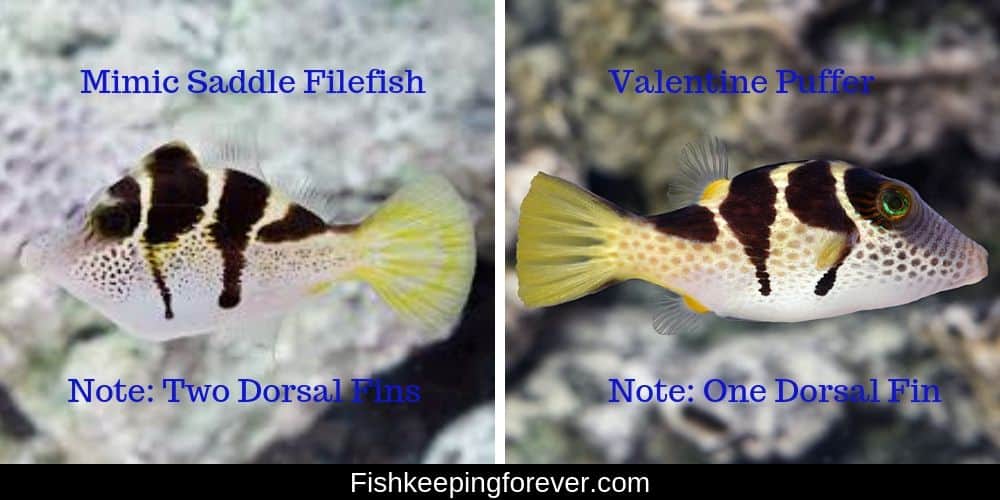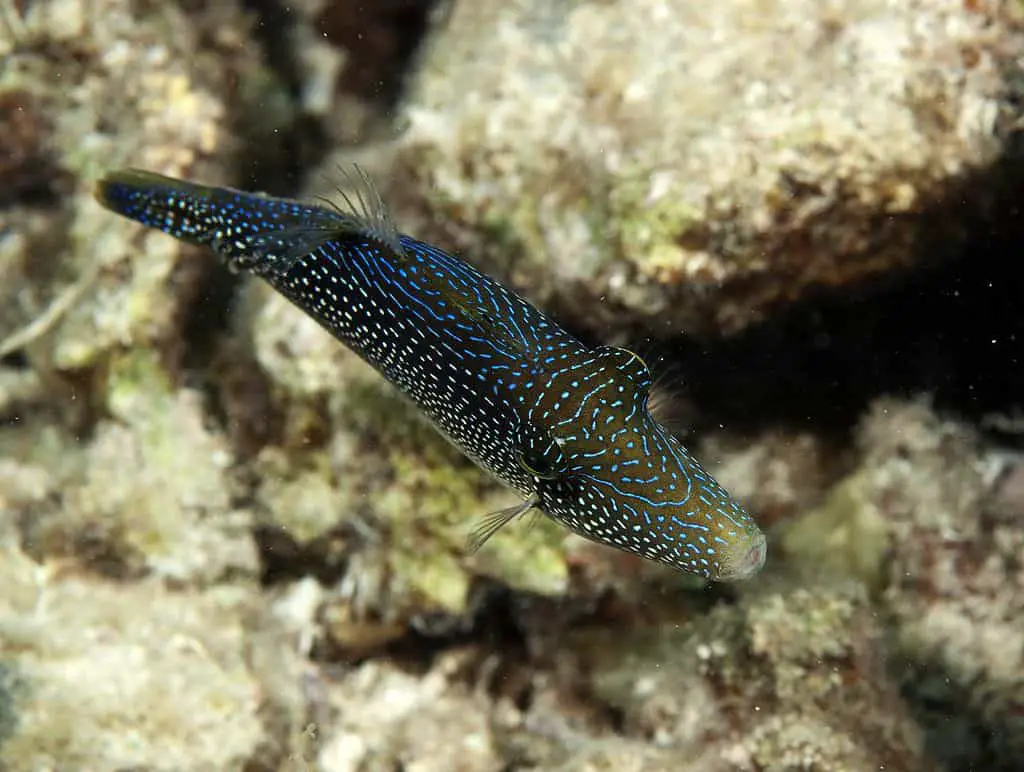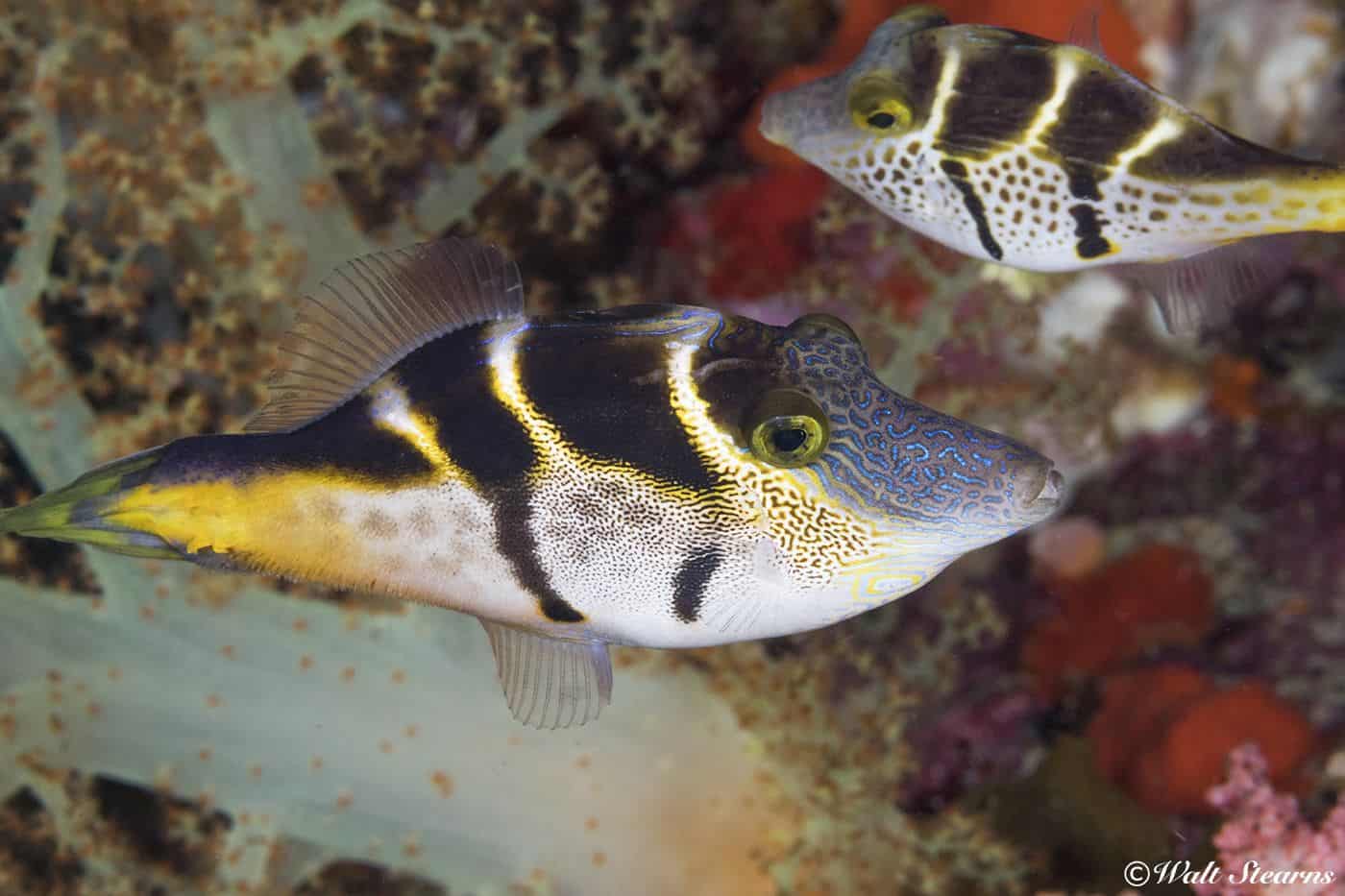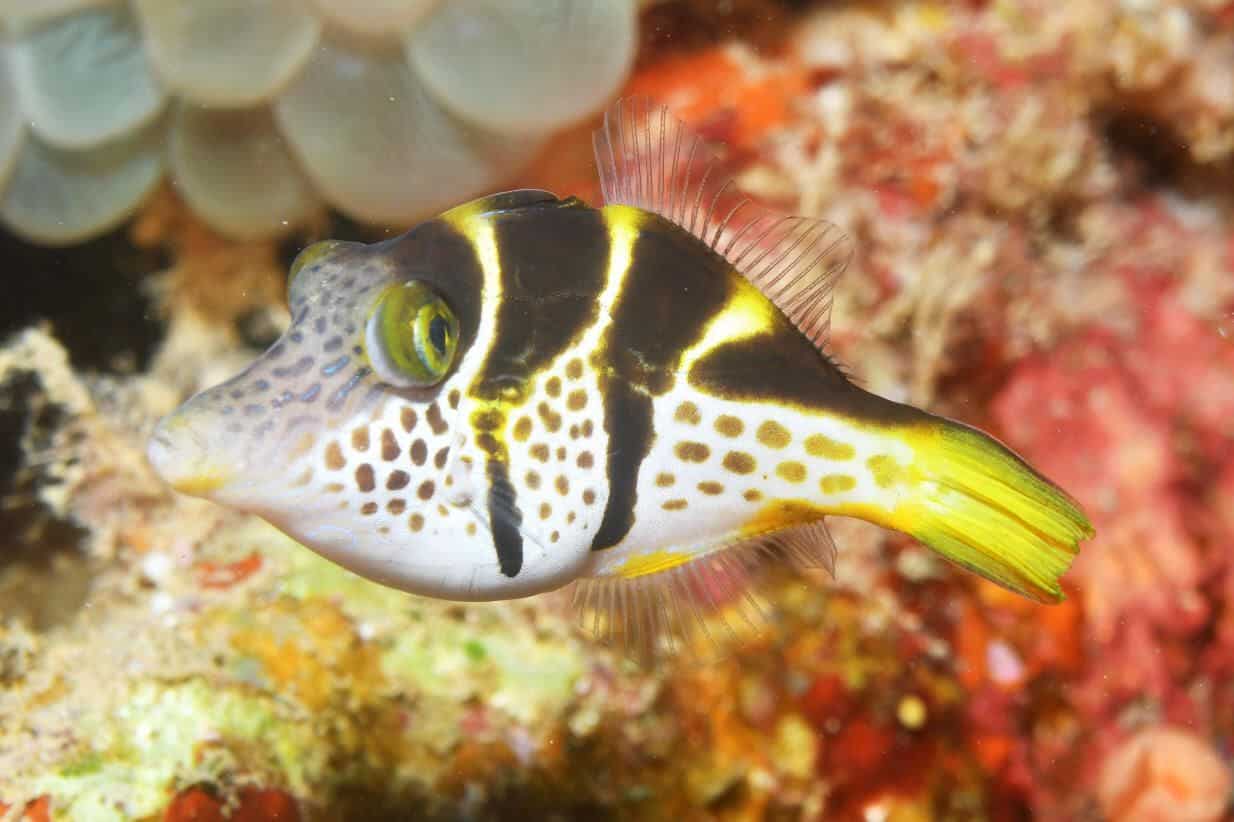If fish could get arrested for being a fraud or a fake then this Mimic Saddle Filefish would be in jail. The Mimic Saddle Filefish is not actually a puffer fish at all it’s a Filefish that has developed over many years to look and act like a puffer fish.
Why? To protect itself from predators.
Pufferfish are poisonous due to tetrodotoxin in their skin and other body tissues. They are poisonous too many fish species and therefore by looking like a pufferfish and acting like one the mimic saddle filefish will deter predators from attacking and trying to eat them. The Mimic Saddle Filefish is not poisonous.
Not only do these filefish look like puffers they also act like them and inhabit the same waters and even shoal and live with the true Valentine Puffers.
I’m not sure if the true Valentine puffer knows if they are Filefish and if they’re happy about it but they seem to accept them living in their space in their natural habitat.
What’s the difference between a Mimic Saddle Filefish & Valentine puffer?
- The Minic saddle Filefish (Paraluterus prionurus) has two Dorsal fins which run the length of their back and the Valentine puffer just has one small Dorsal fin. ( See the Image Below)
- The filefish has a more triangular shape body.
- Check their eyes, the mimic filefish has bigger and more protruding eyes than the Valentine puffer.
- Don’t rely on colors as they can change and are not a reliable way to identify the two types of fish. The (P. prionurus has 27-28 soft dorsal fin rays vs. 10-11 in C. valentini).
- Another clue is if your fish blows up in size… it’s a puffer fish and not a mimic saddle filefish.

Table of Contents
What other names are Mimic Saddle Filefish Known By?
This fish has many common names and it is very easy to get confused. In this article, we will show and explain the simple way to identify them.
Their common names include Mimic Leatherjacket, False Puffer Fish, Blacksaddle Mimic Filefish, Black-Saddle Leatherjacket, Blacksaddle Toby Mimic, Blacksaddled Filefish, Black-Saddled Leatherjacket, Saddled Filefish, Hooked Filefish, Valentini Mimic, Blacksaddle Mimic, Black saddle Filefish.
But their true name is Mimic Saddle Puffer the safest way to order or buy one of these fish is to use their scientific name (Paraluterus prionurus).
I know what your thinking, it should be called Minic Saddle Filefish, Right! Indeed it should but the name has stuck with them for many years so I don’t think it’s going to change anytime soon. So watch out when asking for one, I would ask for a mimic saddle filefish so not to confuse the shopkeeper.
Mimic Saddle Filefish Species Profile
| Scientific Name | Paraluterus prionurus |
|---|---|
| Family name | Balistidae |
| Temperament | Peaceful |
| Good Community Fish | Yes |
| Care Level | Moderate due to diet |
| Diet | Omnivores |
| Ideal food | Meaty foods, seafoods, Marine Algae/Seaweed, Freeze Dried krill |
| Color | Orange, Tan, Yellow, Blue |
| Size | 4-4.5" |
| Perfect size to purchase | 1-2" |
| Jumper? | No |
| Reef Safe | with caution |
| Tank size | 50 Gallon |
| Ideal first fish | Yes, in the right aquarium |
| Desirability | 4.6 out 5 |
| Cost | $20 |
Juvenile and smaller fish can be found in a group of 10 or more, sometimes up to 100 fish have been spotted by divers. These groups are normally a mix of Valentine Puffers and Mimic Saddle Filefish.
As they grow you will find that the males will start to leave the groups and venture out on their own looking for a mate. Once they find their perfect partner they will live in pairs.
They can be found living amongst the coral head in the Pacific Ocean and Indian Ocean, Northern Japan, Australia and New Caledonian in shallow waters up to 100 Meters but normally at around 25-30 Meters. These fish live in perfect harmony and there seems to be no arguments between the true Valentine Puffer and the mimic saddle fraudsters.
There is some confusion over whether these fish live in the Red Sea, the variety living in the Red Sea is Paraluteres Arquat variety of Filefish. Whether or not these fish are direct relations is not yet known and this species of fish is currently being studied in the wild. The colors are totally different (see the photo below)

In a large school, the Mimic Saddle Filefish will make up around 10-15% of the total number of fish in that one school. Living alongside the Puffers offers security and freedom to venture out into open waters in safety. As the puffer fish is poisonous to many fish, the Mimic Puffers are safer in groups than living alone.
When seen at night they follow the habit of many other filefish by pressing themselves up against a piece of coral usually low down on the substrate. Their coloration does not seem to change at night, unlike many other filefish species.
What do Mimic Saddle Filefish Eat?
In the wild, these fish eat a variety of foods and love eating soft invertebrates and sometimes even soft corals, tunicates and sponges. Tube worms, sea star legs. These Filefish are not as destructive as some of the other varieties of Filefish but they can still make short work of Invertebrates within your tank. ( Read the Reef Safe Section Below)
Plankton plays a large part in their diet in the wild and we can never replicate their natural diet in the home aquarium but as responsible aquarists, we must try to provide the best possible diet.
Their diet should consist of a variety of food including dried brine shrimp, squid, scallop, mysis shrimp, freeze-dried krill soaked in a vitamin supplement, and frozen marine algae.
You are always best to feed these fish small portions three times per day or more, this will help deter them from eating any of your invertebrates. Some filefish are notoriously difficult to feed but I have never had an issue with this fish. Mine started feeding after several hours from the rocks and substrate bed. However, it did take sometime before it would eat frozen prawns.
I found that mine loved two types of foods. Frozen prawns and Seaweed Strips. I purchase my seaweed strips from Amazon as I find them cheaper from there. The link provided above.
Their mouths are very small and designed for picking at corals and polyps but they will slowly eat large items like prawns.
It feeds diurnally which means they feed during the day and at night they will rest by wedging themselves between rocks.
Are Mimic Saddle Filefish Reef Safe?
These fish will eat sessile invertebrates with the exception of potent stinging sea anemones such as Stichodactyla spp.
So we advise caution if you would like to add them to a reef aquarium. We have had different experiences with these fish. I had one in my semi-reef aquarium that had a small number of sessile invertebrates and soft corals and I had no problems. I did, however, keep him well fed on a variety of foods and like previously mentions stuffed on frozen prawns and Seaweed strips.
Another one of our writers added one to his well-stocked reef tank and it destroyed his reef within a week so he had to remove him quickly. They will often attack shrimps and eat snails.
What tank mates are suitable for filefish?
These fish are very peaceful and quite passive and docile when first introduced to their new home. They will after a few days start to show their personality and come out into open water. But don’t be surprised if in the first few days they retreat to the safety of the rocks and corals.
You should never keep a Mimic Saddle Filefish with a true Valentine Puffer as the puffer will bully and possible hurt your Filefish.
Keep one per tank unless you can find a true mated pair. These are hard to find but not impossible and are lovely in a larger aquarium. We have seen aquariums with multiple mimic saddle filefish living together in perfect harmony but we wouldn’t risk it.
These fish will not bother any other fish in your aquarium, it’s more a case of what will bother them? Keep similar temperament fish like Damsels, Gobies, Smaller Angelfish, Boxfish, and Clownfish.
The Mimic Saddle Filefish is non-aggressive and a hardy fish suitable for non-reef saltwater aquariums. A good beginners fish as long as your tank conditions are suitable.
The only fish they will not get along with our other filefish.

What size tank and water conditions do Mimic Saddle Filefish need?
Like all saltwater fish the bigger the aquarium the better, but a tank of no smaller than 30 Gallons will be required.
Water conditions are similar to most home reef aquarium conditions 72-78° F, dKH 8-12, pH 8.1-8.4, sg 1.020-1.025. A soft fine substrate is also a good idea as these fish like to eat food from the tank floor from time to time.
Provide plenty of Caves and Living rocks for them to rest on at night. These fish will wedge themselves against the cracks in the rocks or between the glass and rocks. So providing plenty of resting places is very important for these fish. They also like to feed and peck at the rocks.
Provide a soft to medium water current to replicate their natural environment and provide regular water changes to ensure top quality water.
Never overfeed any fish, this is the number one reason for poor water quality and can lead to illness and disease within your tank which could prove to be fatal.
Can you breed Filefish in a home aquarium?
We have not heard of these fish being bred in the home aquarium but pairs are often seen in larger tanks. Zoos and Public aquariums have successfully bred these fish but to our knowledge, no one had bred them in a small home aquarium.
In the wild, the breeding process can involve one male and several females or a solitary pair. Unlike most filefish, these pairs are for life and once paired they rarely leave each for very long.
The females lay her eggs on the substrate which are then fertilized by the male. The female will then guard them to prevent them from being eaten by predators.
If you have successfully bred these fish in a home aquarium we’d love to hear from you.
Filefish Facts
Try to avoid using nets to capture or move a filefish. Due to their skin with its prickly setae, they can become entangled in fine-mesh nets and the fish can quickly become stressed and traumatized. It is better to use a jug or plastic bag to catch and transfer them.
Filefish can alter their color and pattern to match their surroundings and so deter predators from attacking or noticing them. This species of filefish is not poisonous like the species of fish they mimic (Valentine puffers) so they need all the protection they can get from other larger fish.
They are closely related to the Triggerfish, their “trigger spine” cannot be locked into place.
Open top saltwater tanks are fine for these fish as they don’t jump. Bright lighting is preferred with plenty of darker resting places.
They like to be taken care of so provide an active cleaner wrasse to take care of their sensitive and prickly skin. They can change the color of their skin for various reasons so don’t be too alarmed if you see a dramatic change in their skin color. They don’t change color as often as some other filefish but they will from time to time.
The main reason for the color change is if they feel threatened. You will see them wedged in the rocks trying to disguise themselves as rocks to distract predators. The other reason is if the fish is distressed or ill.
This fish is registered on the IUCN Red list of threatened species as LC (LEAST CONCERN) Meaning there is no immediate risk of danger to this species in population and numbers.
| Kingdom: | Animalia |
| Phylum: | Chordata |
| Class: | Actinopterygii |
| Order: | Tetraodontiformes |
| Family: | Monacanthidae |
| Genus: | Paraluteres |
| Species: | P. prionurus |
Conclusion : Mimic Saddle Filefish Care Guide
This fish is not a second class Valentine Puffer, they are wonderful fish and should never be regarded as a poor substitute. I loved mine and named him Harry after Harry Houdini as he could wedge himself in some very tight places and then escape within seconds.
They are very hardy and inexpensive fish that will provide hours of fun and are a pleasure to watch especially if you have a large enough tank to house a pair!
Would we recommend you buy one? Yes, as long as you don’t want a full-blown reef tank then get one, you won’t be disappointed.
- Green Mandarin Dragonet: Diet | Breeding | Size | Cost |Guide
- Firefish Goby: Diet | Size | Care | Lifespan | Cost
- Cleaner Wrasse: Diet | Size | Breeding | Sexing | Cost
- Best Cleanup Crew For a Reef Tank | Algae | Substrate | Scavengers
- Where Does the Mandarin Fish Live?

I have been working in the tropical fish industry for over 30 years now and I’m still learning. Everyday is a school day in this hobby. In my spare time I play golf very badly!



